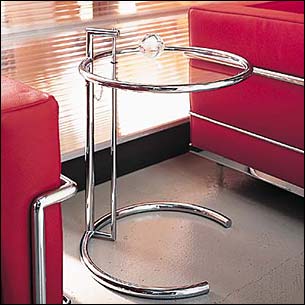 |
| Eames Office Chair by Ray and Charles Eames |
It's hard to explain really, because Bauhaus and the International style were so concurrent that the lines where one movement ends and the other begins hardly exist at all. While the Bauhaus only existed from 1919 to 1933 mainly in Germany, The International Style is thought to have started in 1920 and lasted to about 1980 in... well, pretty much everywhere, thus the name.
It was happening at the same time as popular design movements such as Art Deco, Organic Design, Streamlining
 |
| International style influenced Eileen Gray while designing this Art Deco Table |
This hadn't happened in the western world since the Gothic style in the Middle Ages when every public building was designed in this style in order to communicate without the use of language. That was the key thing to designers in this time. Whereas, in the middle ages Gothic was used to communicate religion to the people, now design was being used to communicate function.
In order to avoid writing the longest blog-post ever in history I will bring this post to a close and continue where I left off in my next post.
REFERENCES:
Thomas Hauffe, 2001. Design: From the Industrial Revolution to the 21st Century (Flipguides). Edition. Dumont Monte.
Charlotte & Peter Fiell, 2012. Design of the 20th Century (25). Edition. Taschen.
, 2001. Design Classics (Architecture & Design) (English and French Edition). Bilingual Edition. Taschen.
Unknown , (2013), Eames Office Chair and Ottoman [ONLINE]. Available at:http://www.fantiques.com/periods/IS.jpg [Accessed 22 November 13].
Unknown , (2013), Eileen Gray Round Table [ONLINE]. Available at:http://ww1.prweb.com/prfiles/2006/08/31/431785/EGTABLE.jpg [Accessed 22 November 13].
No comments:
Post a Comment